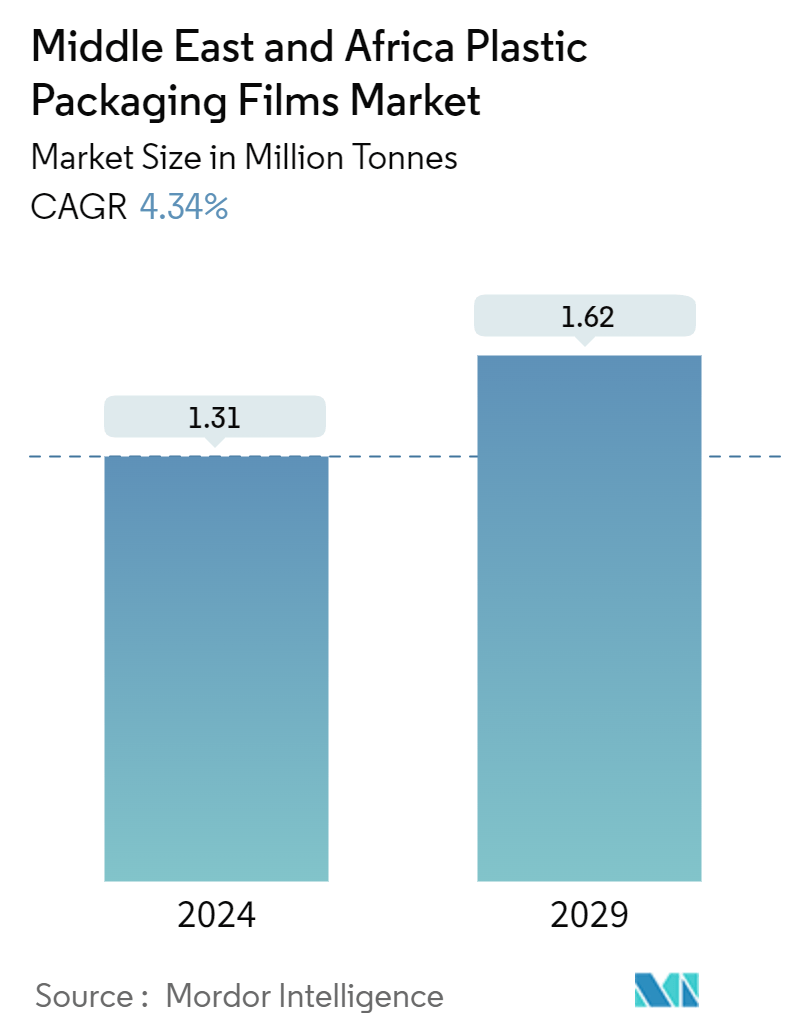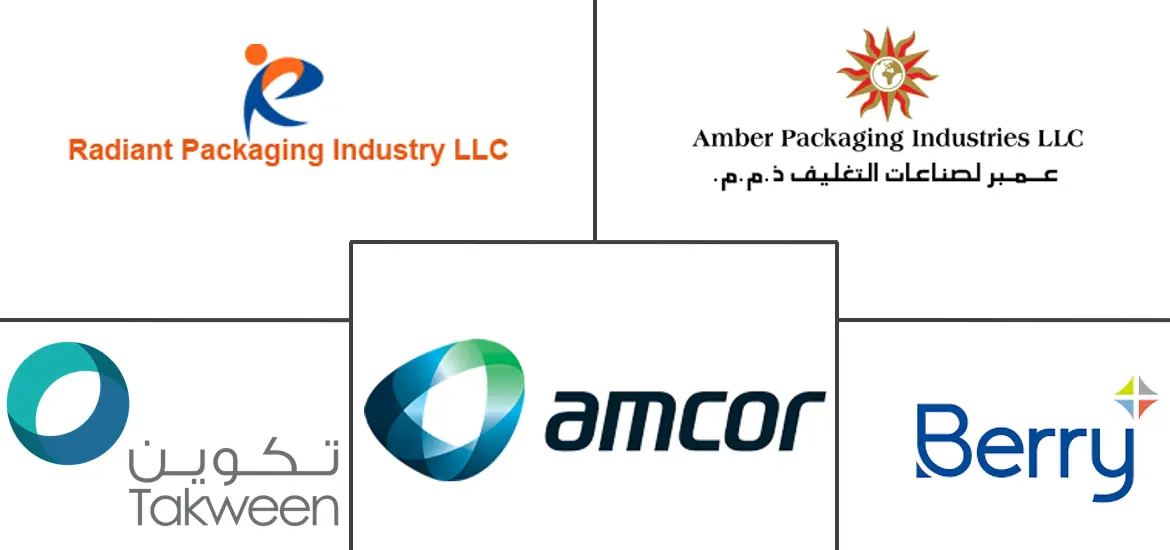Market Size of Middle East And Africa Plastic Packaging Films Industry

| Study Period | 2019 - 2029 |
| Base Year For Estimation | 2023 |
| Forecast Data Period | 2024 - 2029 |
| Historical Data Period | 2019 - 2022 |
| CAGR (2024 - 2029) | 4.34 % |
| Market Concentration | Low |
Major Players
*Disclaimer: Major Players sorted in no particular order |
Middle East And Africa Plastic Packaging Films Market Analysis
The Middle East And Africa Plastic Packaging Films Market size is estimated at 1.31 Million tonnes in 2024, and is expected to reach 1.62 Million tonnes by 2029, growing at a CAGR of 4.34% during the forecast period (2024-2029).
- The plastics industry is mature in the Middle East and Africa (MEA), backed by the growing consumption of plastic films in various end-user industries, including pharmaceutical, food, beverage, personal care, and cosmetics.
- The governments of Saudi Arabia, the United Arab Emirates (UAE), and other Gulf countries invest in sustainable solutions for collecting, sorting, and recycling plastic waste to implement eco-friendly solutions across the plastic value chain.
- In February 2024, the Ministry of Municipality (MoM) Qatar provided recyclable materials free of cost to recycling factories operating in the country to promote sustainability and a circular economy.
- In December 2023, the Alliance to End Plastic Waste signed a Memorandum of Understanding (MoU) with Saudi Investment Recycling Company (SIRC) in Dubai. The strategic partnership aims to implement effective waste management solutions in Saudi Arabia by targeting the challenges posed by specific plastics.
- The availability of recyclable materials from initiatives like the one by the Ministry of Municipality (MoM) Qatar can increase the production of recycled plastic films. This can create a new segment within the plastic packaging film market, catering to environmentally conscious consumers and businesses.
- There is growing awareness and concern about the environmental impact of plastic waste. Many countries in the MEA region are implementing stricter regulations and policies to reduce plastic usage and promote sustainable alternatives. This push toward environmental sustainability can restrain the growth of the plastic packaging film market.
Middle East And Africa Plastic Packaging Films Industry Segmentation
Plastic film packaging refers to various thin plastic materials that wrap or protect products. These films are commonly used in the food, pharmaceutical, and other industries. The report tracks the demand for converted packaging films across major resin and application types. This encompasses a range of materials and uses, reflecting the market's varied requirements and the evolving preferences of consumers and businesses.
The plastic packaging film market in the Middle East and Africa is segmented by type (polypropylene (biaxially oriented polypropylene (BOPP) and cast polypropylene (CPP)), polyethylene (low-density polyethylene (LDPE) and linear low-density polyethylene (LLDPE)), polyethylene terephthalate (biaxially oriented polyethylene terephthalate (BOPET)), polystyrene, bio-based, and PVC, EVOH, PETG, and other film types), end user (food [candy & confectionery, frozen foods, fresh produce, dairy products, dry foods, meat, poultry, and seafood, pet food, and other food products (seasonings & spices, spreadables, sauces, condiments, etc.)], healthcare, personal care & home care, industrial packaging, and other end users), and country (the United Arab Emirates, Saudi Arabia, Egypt, South Africa, Nigeria, Morocco, and the Rest of Middle East and Africa). The market sizes and forecasts are provided in terms of volume (units) for all the above segments.
| By Type | |
| Polypropylene (Biaxially Oriented Polypropylene (BOPP), Cast polypropylene (CPP)) | |
| Polyethylene (Low-Density Polyethylene (LDPE), Linear low-density polyethylene (LLDPE)) | |
| Polyethylene Terephthalate (Biaxially Oriented Polyethylene Terephthalate (BOPET)) | |
| Polystyrene | |
| Bio-Based | |
| PVC, EVOH, PETG, and Other Film Types |
| By End-User Industry | ||||||||||
| ||||||||||
| Healthcare | ||||||||||
| Personal Care & Home Care | ||||||||||
| Industrial Packaging | ||||||||||
| Other End-user Industry Applications (Agricultural, Chemical, etc.) |
| By Country | |
| United Arab Emirates | |
| Saudi Arabia | |
| Egypt | |
| South Africa | |
| Nigeria | |
| Morocco |
Middle East And Africa Plastic Packaging Films Market Size Summary
The Middle East and Africa plastic packaging films market is experiencing steady growth, driven by the increasing demand for plastic films across various sectors such as pharmaceuticals, food, beverages, personal care, and cosmetics. The region's mature plastics industry is supported by significant investments from governments in Gulf countries, focusing on sustainable solutions for plastic waste management. Initiatives like those in Qatar, which provide recyclable materials to promote a circular economy, are expected to create new market segments catering to environmentally conscious consumers. However, the growing awareness of the environmental impact of plastic waste is prompting stricter regulations, which could potentially restrain market growth.
The market is further bolstered by the availability of high-quality polyethylene films, particularly LDPE and LLDPE, produced by companies like SABIC. These materials are essential for applications requiring durability and chemical resistance, especially in the region's harsh environmental conditions. The expansion of the UAE's plastic film packaging market is fueled by increased demand for sustainable packaging solutions and tailored packaging in the e-commerce sector. The pharmaceutical industry's stringent packaging requirements also contribute to the market's growth, driving investments in innovative packaging solutions. The market is characterized by fragmentation, with global players and local manufacturers adopting strategies like collaborations and product launches to enhance their presence and sustainability efforts.
Middle East And Africa Plastic Packaging Films Market Size - Table of Contents
-
1. MARKET INSIGHTS
-
1.1 Market Overview
-
1.2 Industry Attractiveness - Porter's Five Forces Analysis
-
1.2.1 Bargaining Power of Suppliers
-
1.2.2 Bargaining Power of Buyers
-
1.2.3 Threat of New Entrants
-
1.2.4 Threat of Substitutes
-
1.2.5 Intensity of Competitive Rivalry
-
-
1.3 Industry Value Chain Analysis
-
-
2. MARKET SEGMENTATION
-
2.1 By Type
-
2.1.1 Polypropylene (Biaxially Oriented Polypropylene (BOPP), Cast polypropylene (CPP))
-
2.1.2 Polyethylene (Low-Density Polyethylene (LDPE), Linear low-density polyethylene (LLDPE))
-
2.1.3 Polyethylene Terephthalate (Biaxially Oriented Polyethylene Terephthalate (BOPET))
-
2.1.4 Polystyrene
-
2.1.5 Bio-Based
-
2.1.6 PVC, EVOH, PETG, and Other Film Types
-
-
2.2 By End-User Industry
-
2.2.1 Food
-
2.2.1.1 Candy & Confectionery
-
2.2.1.2 Frozen Foods
-
2.2.1.3 Fresh Produce
-
2.2.1.4 Dairy Products
-
2.2.1.5 Dry Foods
-
2.2.1.6 Meat, Poultry, And Seafood
-
2.2.1.7 Pet Food
-
2.2.1.8 Other Food Products (Seasonings & Spices, Spreadable, Sauces, Condiments, etc.)
-
-
2.2.2 Healthcare
-
2.2.3 Personal Care & Home Care
-
2.2.4 Industrial Packaging
-
2.2.5 Other End-user Industry Applications (Agricultural, Chemical, etc.)
-
-
2.3 By Country
-
2.3.1 United Arab Emirates
-
2.3.2 Saudi Arabia
-
2.3.3 Egypt
-
2.3.4 South Africa
-
2.3.5 Nigeria
-
2.3.6 Morocco
-
-
Middle East And Africa Plastic Packaging Films Market Size FAQs
How big is the Middle East And Africa Plastic Packaging Films Market?
The Middle East And Africa Plastic Packaging Films Market size is expected to reach 1.31 million tonnes in 2024 and grow at a CAGR of 4.34% to reach 1.62 million tonnes by 2029.
What is the current Middle East And Africa Plastic Packaging Films Market size?
In 2024, the Middle East And Africa Plastic Packaging Films Market size is expected to reach 1.31 million tonnes.

